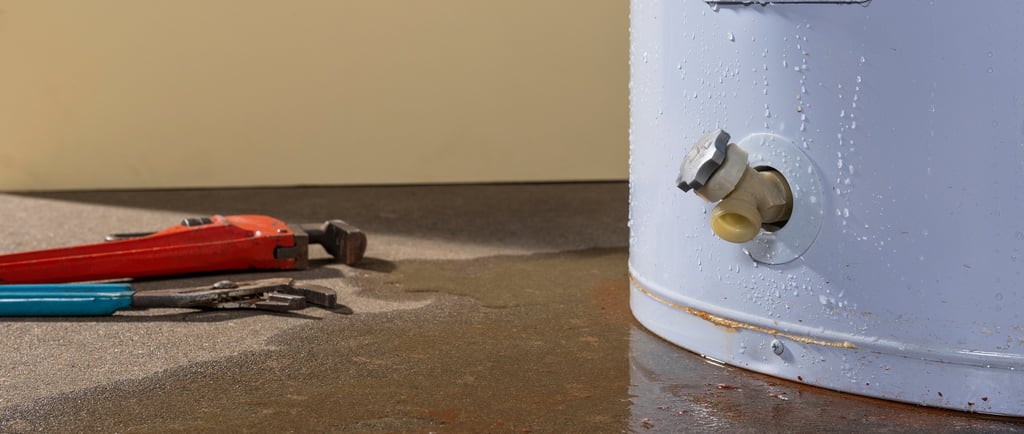How to Know When It's Time to Replace Your Water Heater: Signs That Your Water Heater Is on Its Last Legs
WATER HEATERSEMERGENCY PLUMBINGRESIDENTIAL PLUMBINGFAQS
7/23/20255 min read


Picture this: It’s Monday morning. You stumble into the shower, ready to wash off the weekend. You turn the handle, brace for bliss… and instead get a faceful of freezing betrayal. Yep—your water heater is ghosting you.
But here’s the thing: water heaters rarely die quietly. They throw tantrums. They send cryptic messages. They creak, gurgle, spit rust, and hike your power bill like it’s training for Everest. You just have to know how to read the signs.
Let’s decode the drama. These are the red flags, weird noises, and hot-and-cold games that scream, “Hey! I’m on my last legs!”—and what to do before your water heater goes full zombie on you.
🚿 1. Your Shower Turns Cold Mid-Chorus
You’re singing like Beyoncé, the steam is rising, the vibes are immaculate—and then WHAM. Arctic blast.
If your hot water runs out faster than your phone battery, that’s a classic signal your water heater’s tank is coated with sediment. Like, thick oatmeal levels of buildup. That sediment acts like insulation—in the worst way—trapping heat at the bottom and blocking your water from warming up.
Translation: You get less hot water, and the stuff you do get cools down faster than a ghosted text.
Cue dramatic exit music for your water heater.
🎧 2. Your Water Heater’s Making Creepy Noises
Tick. Pop. Bang. Whomp-whomp.
If your water heater sounds like it’s auditioning for a haunted house soundtrack, it’s time to listen—literally.
Those rumbling or popping sounds? That’s boiling water trying to push through layers of hardened sediment at the bottom of your tank. Think mini pressure cookers going off every time it runs. Not only is it spooky, it’s rough on your tank’s insides.
Verdict: Your heater’s throwing a full-on tantrum. Ignore it, and you’re one crack away from a leak.
🛑 3. You See Rusty Water (or Taste It—Ew)
Pour yourself a glass of hot water from the tap (yes, hot). Now look closely. If it’s murky, orange-tinted, or has a suspicious “metallic” taste, your tank might be rusting from the inside.
The culprit is probably your anode rod—basically the tank’s bodyguard. Once it’s worn down, the tank itself starts corroding. And rust in your water? That’s not just nasty—it’s your water heater’s death rattle.
PSA: Rust = run. Replacement is knocking on your door.
💦 4. There’s a Tiny Pond Forming at the Base
Small puddle? Just a drip? Cute, right? Wrong.
Even the tiniest moisture collecting around the base of your water heater could be a sign of internal cracks in the tank. When the metal heats up, it expands—and that’s when hairline fractures leak water. It might reseal when it cools, tricking you into thinking it’s “not that bad.”
Spoiler: It is. And it’s only getting worse.
Trust us—replacing a water heater is way cheaper than replacing your entire basement floor.
🔁 5. It’s Old. Like, Real Old.
Water heaters aren’t forever friends. Most last 8 to 12 years tops—especially traditional tank models. If yours is creeping into its teenage years, every day is a dice roll.
You don’t want to be that person buying a new water heater in a panic on Thanksgiving morning because Aunt Carol needs to shower.
Pro tip: Find your unit’s serial number. That code can tell you the manufacturing date. If it was made during the Obama administration, start shopping.
💡 6. Your Utility Bill Just Did a Backflip
When your water heater ages, it starts working harder to do the same job. It’s like forcing an elderly marathon runner to sprint uphill carrying groceries. It burns more gas or electricity, takes longer to heat, and cycles more often.
If your utility bill is giving drama, but nothing else in the house has changed, your water heater might be the sneaky little money vacuum.
Want to save? Upgrade to a newer energy-efficient model before your bank account starts sobbing.
⚖️ 7. It Needs Constant TLC (And It’s Not Cute Anymore)
If you’re on a first-name basis with your plumber—or worse, watching YouTube tutorials in the middle of the night—it might be time to stop patching the Titanic.
Fixing old water heaters over and over is like duct-taping a collapsing bookshelf. Sure, it holds for now. But do you really want to trust it with your hot water needs?
Financial reality check: If repairs cost more than 50% of a new unit, it’s smarter to replace.
🌡️ 8. Inconsistent Water Temps (a.k.a. Russian Roulette Showers)
One second, it’s lukewarm. The next, it’s boiling lava. And then—nothing but ice water. If your shower feels like an unpredictable arcade game, your thermostat or heating element might be on its last nerve.
Sometimes it’s fixable. But if you’ve already replaced parts and the chaos continues, the whole unit may be fried.
Hot tip (literally): Consistent temps = a healthy heater. Wild swings? It's probably waving the white flag.
🔥 9. The Pilot Light’s Playing Games (for Gas Heaters)
If your gas water heater’s pilot light keeps going out, that’s a problem. It could be a faulty thermocouple or gas valve, or it could be the entire unit calling it quits.
Relighting the pilot every few days isn’t a hobby—it’s a hazard. Don’t wait for carbon monoxide drama or gas leaks.
Bottom line: If your heater won’t stay lit, it might be time to let it go.
🌬️ 10. The Burner Flame Is Yellow (Not Blue)
Gas water heater owners, peek at the burner flame. It should be crisp, strong, and blue.
If it’s yellow or flickering like a sad candle, you might have poor combustion—or worse, a carbon monoxide risk.
Either way: this isn’t just a performance issue. It’s a safety issue. And it usually means your water heater is aging out of its prime.
✅ What to Do If You’re Seeing These Signs
If two or more of these red flags are happening at your house, your water heater’s trying to tell you something. Loudly.
Here’s your battle plan:
Check the age of your unit (look up that serial number)
Inspect for leaks, rust, or puddles
Watch your water temps and listen for weird noises
Track your utility bills
Call a licensed plumber for a full inspection
Smart move: Don’t wait until it fails on the coldest day of the year (because yes, that’s exactly when it will fail). Replacing a water heater on your terms, before it explodes into a disaster, saves you stress, money, and mopping time.
🧠 Final Thought: Know the Signs = Avoid the Chaos
Look—we get it. Your water heater is easy to ignore… until it betrays you in your hour of need. But with just a little attention, you can catch the warning signs early and replace it before the flood, before the ice-bath shower, and before you’re googling “emergency plumber near me” at 2 a.m.
The signs are there. You just have to know how to read them.
If your water heater is sending out smoke signals (or sulfur smells, or screechy pops), listen up. Because it’s not being dramatic—it’s being honest. And it’s probably begging for retirement.
Want help decoding your unit’s symptoms? Reach out to a pro and skip the water heater horror story altogether.
Cold showers are only trendy on TikTok. In real life? Not so much.
Contact
Main Office
Social
3560 S 2200 W
West Valley City, UT 84119
P.O. Box 25123
Salt Lake City, UT 84125
Monday – Friday:
7:00 am – 3:30 pm
Billing & Mailing Address
Hours
© Budd M. Rich Plumbing Company, DBA BRPI Mechanical. All rights reserved.
